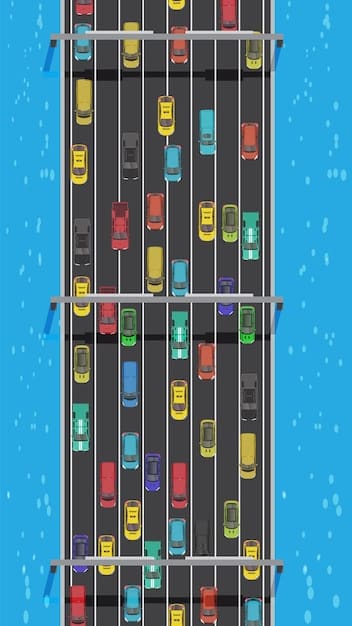US Autonomous Vehicles: Latest Developments & Future

Advertisements
The United States is experiencing significant advancements in autonomous vehicle technology, driven by innovations in sensor fusion, artificial intelligence, and regulatory frameworks, signaling a transformative shift in transportation with both immense potential and complex challenges.
Advertisements
The landscape of transportation is undergoing a profound transformation, spearheaded by the rapid evolution of autonomous vehicle technology. In the US, this field is not merely advancing; it’s redefining the very concept of mobility. From urban centers to sprawling highways, what are the Latest Developments in Autonomous Vehicle Technology in the US? This exploration delves into the cutting-edge innovations, intricate regulatory shifts, and the compelling challenges shaping this revolutionary industry.
Advertisements
Sensor Fusion and AI: The Core of Autonomy
At the heart of the latest advancements in autonomous vehicle technology lies the sophisticated interplay of sensor fusion and artificial intelligence. These two pillars are fundamental to how self-driving cars perceive their environment, make decisions, and navigate safely. Without robust sensing capabilities and intelligent processing, autonomous operation remains a theoretical concept rather than a practical reality on public roads.
The integration of various sensor types, such as lidar, radar, cameras, and ultrasonic sensors, forms the backbone of environmental perception. Each sensor offers unique advantages and limitations, and their combined data provides a comprehensive, redundant view of the vehicle’s surroundings. This multi-modal approach enhances reliability and safety, particularly in challenging conditions like adverse weather or poor lighting.
Enhanced Perception Systems
Modern autonomous vehicles employ increasingly refined perception systems. Lidar (Light Detection and Ranging) generates precise 3D maps of the environment, crucial for understanding distances and object shapes. Radar excels at detecting speed and distance, particularly useful for adaptive cruise control and collision avoidance in rain or fog. Cameras, often equipped with high resolution and robust image processing, identify traffic lights, lane markings, and pedestrians.
- Lidar advancements: Miniaturization and cost reduction are making lidar more viable for mass production, while new solid-state lidar technologies promise greater reliability and range.
- Radar evolution: High-resolution radar is emerging, capable of distinguishing smaller objects and providing more detailed environmental data, complementing lidar and cameras.
- Camera intelligence: Deep learning algorithms are continuously improving camera-based object recognition, allowing vehicles to interpret complex road scenarios with human-like discernment.
Beyond individual sensor improvements, the true power lies in sensor fusion algorithms. These algorithms take disparate data streams from multiple sensors and combine them into a single, cohesive, and highly accurate model of the world around the vehicle. This redundancy and cross-validation minimize the impact of individual sensor failures or limitations, leading to safer and more robust autonomous driving. The vehicle’s ability to “see” and “understand” its surroundings is directly proportional to the sophistication of its sensor fusion capabilities.
Artificial intelligence, specifically machine learning and deep learning, is the brain processing this vast amount of sensory data. AI models are trained on billions of miles of real-world driving data, allowing them to recognize patterns, predict behaviors of other road users, and make split-second decisions. This includes everything from path planning and obstacle avoidance to predicting pedestrian movements and adapting to dynamic traffic flows. The continuous learning loop, where vehicles refine their AI models based on new driving experiences and simulation, is crucial for improving their performance and safety over time.
The synergy between cutting-edge sensors and advanced AI is pushing the boundaries of what autonomous vehicles can achieve. These technological breakthroughs are not just incremental improvements; they represent a foundational shift, enabling vehicles to navigate increasingly complex urban environments and diverse driving conditions safely and efficiently. This progress lays the groundwork for wider adoption and a future where autonomous driving becomes a routine aspect of daily life.
Regulatory Frameworks and Public Acceptance
While technological advancements are undeniably crucial, the widespread deployment of autonomous vehicles in the US hinges significantly on the evolution of regulatory frameworks and, perhaps even more so, on gaining public acceptance. The legal and social landscapes are as complex and dynamic as the technology itself, posing unique challenges that must be addressed concurrently with engineering breakthroughs.
Currently, there isn’t a single, cohesive federal regulatory framework governing autonomous vehicles in the US. Instead, a patchwork of state-level laws and guidelines dictates their testing and deployment. This fragmented approach can create hurdles for manufacturers seeking to operate across state lines and can lead to inconsistencies in safety standards and consumer protection. Efforts by federal agencies, such as the National Highway Traffic Safety Administration (NHTSA), focus on developing voluntary guidelines and research to inform future regulations, but legislation has been slow to materialize.
State-Level Initiatives and Federal Discussions
Many states have taken proactive steps, passing legislation that permits the testing and even commercial operation of autonomous vehicles, often with varying degrees of human supervision requirements. California, Arizona, and Texas, for instance, have become hotspots for AV testing due to their relatively clear regulatory environments. These state-level initiatives serve as living laboratories, providing valuable data and insights that could inform a future national framework.
- Safety standards: The discussion revolves around developing performance-based safety standards rather than prescriptive design mandates, allowing for technological flexibility.
- Liability: A key legal question involves assigning liability in the event of an accident involving an autonomous vehicle, with current debates considering the roles of manufacturers, operators, and even software developers.
- Data privacy: The vast amounts of data collected by autonomous vehicles raise significant privacy concerns, necessitating robust regulations to protect sensitive information.
Gaining public trust and acceptance is equally, if not more, critical. High-profile accidents, even if rare, tend to erode confidence in the technology. Therefore, manufacturers and regulators must transparently communicate the safety benefits, limitations, and operational norms of autonomous vehicles. Education campaigns, real-world demonstrations, and a proven track record of safe operation are vital for fostering widespread adoption. Addressing concerns about job displacement in the transportation sector, particularly for professional drivers, is another socio-economic challenge that requires thoughtful consideration and proactive solutions, such as retraining programs.

The journey towards fully autonomous transportation is not just a technological race but also a societal one. Harmonizing regulations, establishing clear legal precedents, and building unwavering public confidence are indispensable steps toward integrating autonomous vehicles seamlessly and safely into the national transportation system. Progress on these fronts is often slower than technological breakthroughs, but it is ultimately what will determine the pace and scale of deployment.
Advanced Mapping and Navigation Systems
For autonomous vehicles to operate effectively and safely, particularly on complex road networks, highly precise and continuously updated mapping and navigation systems are paramount. Standard GPS, while useful for general routing, lacks the centimeter-level accuracy and granular detail required for self-driving cars to understand their exact position, identify lane boundaries, and predict road features with sufficient reliability.
The latest developments in this area focus on creating high-definition (HD) maps. These are not merely digital representations of roads but rather rich, layered datasets that include precise information about lane markings, traffic signs, traffic light locations, road curvature, gradients, and even the reflectivity of surfaces. Such maps serve as a crucial reference point for the vehicle’s onboard sensors, allowing it to localize itself with extreme accuracy and anticipate upcoming road conditions even when sensor visibility is compromised.
HD Mapping and Real-time Localization
HD maps are typically created using a combination of specialized mapping vehicles equipped with lidar, high-resolution cameras, and GPS receivers, along with crowdsourced data from consumer vehicles. Maintaining the freshness and accuracy of these maps is an ongoing challenge, as road construction, temporary closures, and changes in signage necessitate constant updates. Over-the-air (OTA) updates and real-time crowd-sourced data collection are becoming vital for keeping these maps current.
- Sensor-to-map matching: Vehicles use their onboard sensors to match real-time observations against the HD map, allowing for highly precise localization even in the absence of GPS signals (e.g., in tunnels or urban canyons).
- Predictive path planning: HD map data informs the vehicle’s trajectory planning, enabling smoother and safer maneuvers, especially around curved roads or complex intersections.
- Dynamic map layers: New systems are incorporating dynamic layers into HD maps, providing real-time information on traffic incidents, temporary construction zones, and weather conditions.
Beyond static mapping, dynamic navigation systems are crucial. These systems integrate real-time traffic data, weather information, and other dynamic elements to optimize routes and ensure safe operation. This means autonomously rerouting around congestion, adjusting speed for hazardous weather conditions, or receiving alerts about unexpected road debris. The ability to adapt to unforeseen circumstances is a hallmark of truly advanced autonomous navigation.
Significant progress is also being made in developing robust localization techniques that work even when traditional GPS is unavailable or unreliable. This includes visual odometry, where cameras track the vehicle’s movement relative to its surroundings, and inertial measurement units (IMUs) that track acceleration and rotation. The combination of these techniques, coupled with HD maps, allows autonomous vehicles to maintain a high level of positional accuracy in virtually any environment. The sophistication of these mapping and navigation systems is directly linked to the operational design domain (ODD) of autonomous vehicles, determining where and under what conditions they can safely operate.
The evolution of advanced mapping and navigation ensures that autonomous vehicles possess not just a generalized understanding of the road network but a precise, detailed, and up-to-the-minute awareness of their immediate operational environment. This granular level of information is not merely a convenience but a cornerstone of safety and efficiency for autonomous driving.
Ethics, Safety, and Social Implications
The discussion around autonomous vehicle technology in the US extends far beyond silicon and algorithms; it deeply intersects with ethics, safety, and broad social implications. As these vehicles move from controlled test environments to public roads, complex questions arise that challenge existing legal frameworks, societal norms, and moral considerations.
The ethical dilemmas surrounding autonomous vehicles often capture public attention, particularly concerning “trolley problem” scenarios—situations where the vehicle might have to choose between two unavoidable harmful outcomes. While simplified in media, these thought experiments highlight the need for transparent programming principles and clearly defined ethical guidelines. Manufacturers are grappling with how to program vehicles to make decisions in morally ambiguous situations, acknowledging that values-based choices will inevitably be embedded in their algorithms.
Defining Safe Operation and Liability
Safety is paramount, and autonomous vehicles are designed with the explicit goal of reducing traffic accidents caused by human error, which accounts for over 90% of current incidents. The challenge lies in proving that autonomous vehicles are statistically safer than human-driven ones, a bar that requires extensive testing and meticulous data collection. The definition of what constitutes “safe enough” is a subject of ongoing debate among engineers, regulators, and the public.
- Accident investigation: Establishing clear protocols for investigating accidents involving autonomous vehicles, including access to black box data and operational logs.
- Cybersecurity: Protecting autonomous vehicles from hacking and cyber threats is crucial, as a compromise could lead to loss of control or manipulation of vehicle behavior.
- Human-machine interaction: Designing intuitive interfaces for human occupants to understand the vehicle’s intentions and intervene when necessary, especially in partially autonomous systems.
The social implications of widespread autonomous vehicle adoption are profound. Economically, there are concerns about job displacement, particularly in the trucking and taxi industries. Conversely, new jobs in manufacturing, maintenance, data analysis, and software development are expected to emerge. Urban planning could be fundamentally reshaped, with reduced parking needs, altered traffic flows, and potential shifts in urban sprawl dynamics as commuting becomes less burdensome. Accessibility for the elderly, disabled, and non-drivers could significantly improve, offering greater independence and mobility.

Public perceptions, fear of the unknown, and concerns about technology becoming overly pervasive must be carefully managed. Open dialogue, clear communication from developers and regulators, and a demonstrated commitment to safety and ethical considerations are vital for securing the long-term societal acceptance necessary for autonomous vehicles to realize their full potential. The ethical quandaries and societal shifts are not just footnotes but intertwined challenges that will shape how this transformative technology is integrated into the fabric of American life.
Infrastructure Adaptation and V2X Communication
While autonomous vehicles are designed to operate independently, their full potential can only be realized through comprehensive infrastructure adaptation and the widespread adoption of Vehicle-to-Everything (V2X) communication. These developments move beyond the vehicle itself, envisioning a future where cars communicate not only with each other but also with the surrounding environment, enhancing safety, efficiency, and overall autonomy.
Current road infrastructure, largely designed for human drivers, presents limitations for autonomous systems. Pavement markings can be faded or obscured, signage may be inconsistent, and construction zones can pose unpredictable challenges. Future infrastructure ideally would be “smart,” meaning it actively supports autonomous navigation. This could involve clearer, more consistent lane markings; digital traffic signs that communicate directly with vehicles; and sensors embedded in roads to monitor traffic flow, road conditions, and even detect hazards.
The Role of V2X Communication
V2X communication is a critical enabling technology for advanced autonomous driving. It encompasses several modes:
- Vehicle-to-Vehicle (V2V): Allows cars to exchange information directly with each other, such as speed, heading, braking events, and hazards, enabling proactive collision avoidance and cooperative maneuvers.
- Vehicle-to-Infrastructure (V2I): Enables vehicles to communicate with road infrastructure like traffic lights, road-side units, and smart crosswalks. This can optimize traffic flow, provide early warnings about road closures, or inform vehicles about upcoming signal changes.
- Vehicle-to-Pedestrian (V2P) and Vehicle-to-Network (V2N): These extend the communication network to vulnerable road users with compatible devices (e.g., smartphones) and to cloud-based services for real-time updates and data exchange, respectively.
The standardization of V2X technologies is a key challenge. While Dedicated Short-Range Communications (DSRC) was an early contender, cellular V2X (C-V2X), leveraging 5G cellular networks, is gaining traction due to its broader connectivity and higher bandwidth potential. C-V2X promises to facilitate more complex cooperative driving scenarios, real-time traffic management, and enhanced safety warnings for autonomous and human-driven vehicles alike.
Widespread deployment of smart infrastructure and V2X will require significant investment and coordination between government agencies, technology companies, and automotive manufacturers. Pilot programs are underway in several US cities, testing the feasibility and benefits of these integrations. For example, some cities are deploying smart traffic signals that can communicate their status to approaching autonomous vehicles, allowing for smoother traffic flow and potentially reducing stop-and-go driving.
The shift towards an intelligent transportation system, where vehicles and infrastructure are in constant communication, promises to unlock new levels of safety and efficiency. This integrated approach will not only enhance the capabilities of autonomous vehicles but also lay the groundwork for a more resilient and responsive transportation network for all road users. The symbiotic relationship between advanced vehicles and smart infrastructure is essential for building the self-driving future.
Future Outlook and Commercialization Paths
The future outlook for autonomous vehicle technology in the US is bright yet complex, characterized by a gradual but accelerating path to commercialization. As the technology matures and regulatory landscapes clarify, the focus is shifting from purely technological feasibility to strategic deployment models and market penetration. Different approaches to commercialization are emerging, illustrating the varied pathways companies are taking to bring autonomy to the masses.
One primary pathway involves ride-hailing services. Companies like Waymo (Google’s self-driving division) and Cruise (GM’s subsidiary) are already operating fully autonomous ride-hailing services in select US cities, albeit with limited operational design domains (ODDs). These services build trust by offering direct, tangible experiences with the technology, and they provide valuable data for continuous improvement. The controlled environment of a ride-hailing fleet allows for centralized management, rapid software updates, and dedicated support infrastructure.
Beyond Ride-Hailing: Trucking and Logistics
Another significant commercialization frontier is autonomous trucking and logistics. The long-haul trucking industry faces severe driver shortages and offers immense potential for efficiency gains through autonomous operation. Companies like TuSimple and Embark Trucks are developing Level 4 autonomous truck systems, focusing on highway driving, which is less complex than urban environments. This can reduce fuel consumption, optimize delivery times, and operate around the clock, revolutionizing the supply chain.
- Last-mile delivery: Autonomous robots and smaller vehicles are being developed for local, last-mile delivery of goods, reducing operational costs for e-commerce and logistics companies.
- Personal ownership: The timeline for widespread personal ownership of fully autonomous vehicles (Level 5) remains more distant, largely due to cost, regulatory hurdles, and the need for universal operational domains.
- Public transportation: Autonomous shuttles and buses are being piloted in various cities, addressing the need for efficient public transit solutions, particularly in underserved areas or for dedicated routes.
Investment in the sector remains robust, attracting venture capital and strategic partnerships between tech giants and traditional automakers. Mergers and acquisitions are also consolidating the market, as companies seek to combine expertise and resources to overcome the considerable developmental and regulatory challenges. The next few years will likely see a continued expansion of autonomous ride-hailing in more cities, as companies refine their operational capabilities and expand their ODDs.
The journey towards a fully autonomous transportation system is an iterative one, marked by continuous innovation, careful regulatory navigation, and strategic market entry. While challenges persist, the clear benefits in safety, efficiency, and accessibility provide strong impetus for continued investment and development. The US is at the forefront of this revolution, poised to witness the transformative impact of autonomous vehicles on daily life and the broader economy.
Cybersecurity and Data Privacy Challenges
As autonomous vehicles become increasingly connected and reliant on complex software, the challenges of cybersecurity and data privacy become paramount. These are not merely technical hurdles but also critical trust factors that could significantly influence public acceptance and the long-term viability of autonomous transportation in the US. Protecting these vehicles from malicious attacks and safeguarding the vast amounts of personal and operational data they generate are top priorities.
Autonomous vehicles are essentially computers on wheels, making them susceptible to the same types of cyber threats that plague other networked systems. A successful cyberattack could range from disabling vehicle functions to manipulating navigation systems, or even taking full control, potentially leading to catastrophic consequences. The attack surface is vast, encompassing everything from vehicle-to-everything (V2X) communication channels, software updates, and internal vehicle networks to sensor data streams and cloud-based services.
Protecting the Connected Car Ecosystem
Developing robust cybersecurity measures involves a multi-layered approach. This starts with secure-by-design principles in hardware and software development, implementing strong encryption protocols for data transmission, and employing intrusion detection systems to monitor for unusual activity. Regular software updates are also critical to patch vulnerabilities as they are discovered. The supply chain for autonomous vehicle components and software also represents a potential risk, requiring rigorous vetting and security audits throughout the entire ecosystem.
- Secure software updates: Ensuring that over-the-air (OTA) updates are authenticated, encrypted, and impervious to tampering.
- Threat intelligence sharing: Fostering collaboration among manufacturers, suppliers, and government agencies to share information on emerging threats and best practices.
- Resilience and redundancy: Designing systems with fail-safe mechanisms and redundant controls to prevent a single point of failure from a cyberattack.
Equally pressing are the concerns surrounding data privacy. Autonomous vehicles collect an enormous volume of data, including location information, driving patterns, passenger behavior, and even environmental data through their sensors. This data, while essential for vehicle operation and improvement, is highly sensitive and could be used for surveillance, targeted advertising, or even tracking if not properly protected.
Regulations such as the California Consumer Privacy Act (CCPA) provide some guidance, but specific federal legislation tailored to the unique data collection practices of autonomous vehicles is still evolving. Consumers need assurances that their personal data will be anonymized, aggregated, and used only for legitimate purposes, and that they have control over its sharing. Industry standards and ethical guidelines for data collection, storage, and usage are being developed to build consumer trust.
The integration of cybersecurity from the earliest design stages and a proactive approach to data privacy are not optional extras but fundamental requirements for autonomous vehicles to gain widespread acceptance and operate safely and ethically on US roads. Addressing these challenges effectively will be a continuous effort, evolving as the technology itself advances and as new threats emerge. It’s a race against time between innovation and potential vulnerabilities, where continuous vigilance is key.
| Key Development | Brief Description |
|---|---|
| 🚀 Sensor Fusion & AI | Combines Lidar, Radar, and Cameras with advanced AI for precise environmental perception and decision-making. |
| ⚖️ Regulatory & Public Trust | Navigating fragmented state laws and building public acceptance through proven safety and clear communication. |
| 🗺️ HD Mapping & Navigation | High-definition maps and real-time localization for precise vehicle positioning and predictive path planning. |
| 📡 V2X Communication | Vehicle-to-Everything communication for enhanced safety, traffic optimization, and cooperative driving. |
Frequently Asked Questions
▼
While fully autonomous vehicles (Level 5) are in advanced testing, Level 2 (partial automation with driver supervision) and Level 3 (conditional automation) systems are becoming more common in consumer vehicles. These include features like adaptive cruise control, lane-keeping assist, and hands-free driving capabilities on specific highways.
▼
Adverse weather (heavy rain, snow, fog) remains a significant challenge. Developers are addressing this through improved sensor technologies like high-resolution radar, specialized lidar, and heated sensor housings. Advanced AI algorithms are also trained to interpret limited visibility conditions, but safe operation often requires reducing speed or resorting to human oversight.
▼
The primary hurdles include the lack of a unified federal regulatory framework, creating a patchwork of state laws. Key areas of concern are developing consistent safety standards, establishing clear liability rules in case of accidents, and addressing data privacy issues related to the vast amounts of information collected by these vehicles.
▼
Autonomous vehicles are designed to significantly reduce accidents by eliminating human error, which causes most crashes. While they won’t make accidents completely extinct due to unforeseen external factors or system malfunctions, they are expected to dramatically improve road safety and reduce fatalities and injuries over time.
▼
The most likely first widespread uses are in controlled environments or specific operational design domains. Autonomous ride-hailing services in major cities with predictable routes and autonomous long-haul trucking on highways are currently leading the commercialization efforts, offering practical applications well before widespread personal ownership.
Conclusion
The journey of autonomous vehicle technology in the US is a testament to relentless innovation and complex challenges. From the sophisticated dance of sensor fusion and AI to the intricate ballet of regulatory frameworks, public acceptance, and ethical considerations, every facet plays a vital role. While full Level 5 autonomy for personal vehicles might still be some years away, the progress in ride-hailing, logistics, and V2X communication signals a clear trajectory towards a more automated, efficient, and potentially safer transportation future. The developments are not merely technological but societal, promising to redefine urban living, revolutionize industries, and fundamentally alter our relationship with mobility.





